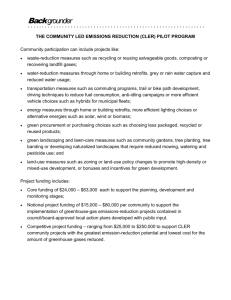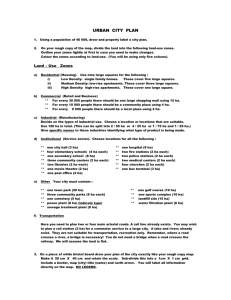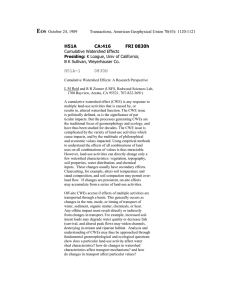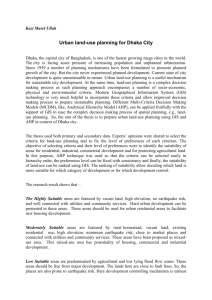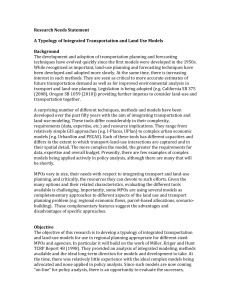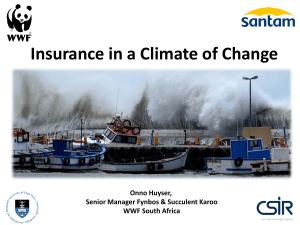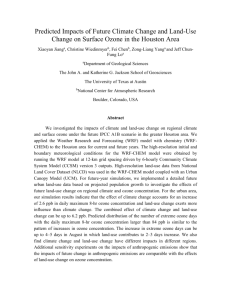GIS AND REMOTE SENSING TECHNIQUES APPLIED FOR LAND-USE SUITABILITY STUDY
advertisement
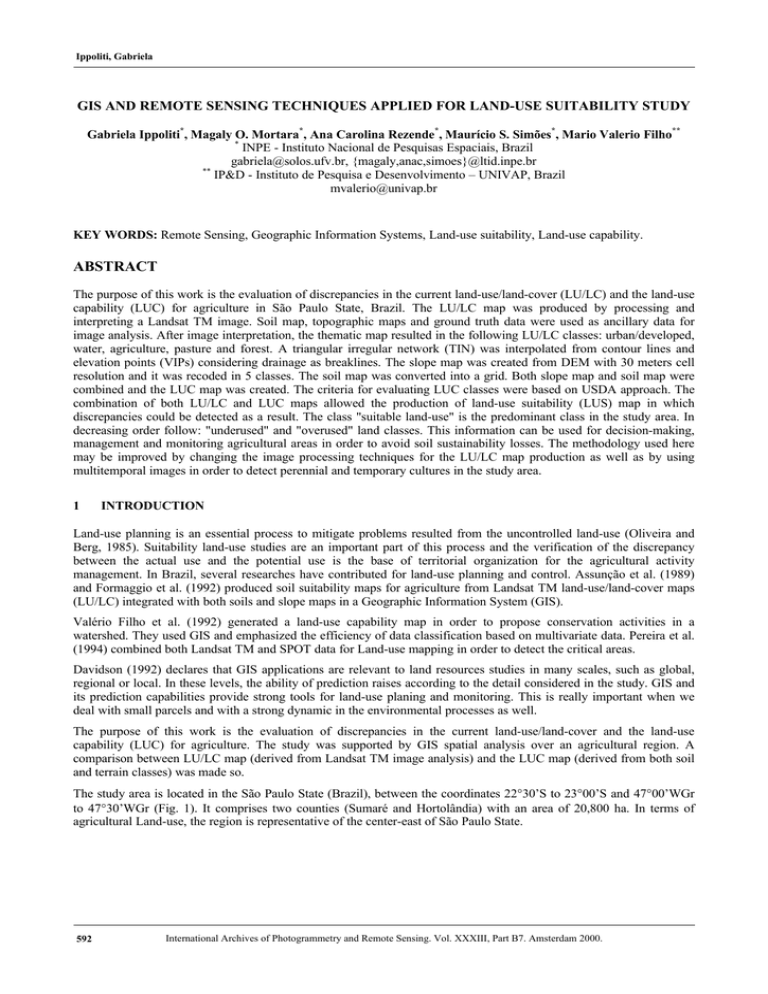
Ippoliti, Gabriela
GIS AND REMOTE SENSING TECHNIQUES APPLIED FOR LAND-USE SUITABILITY STUDY
Gabriela Ippoliti*, Magaly O. Mortara*, Ana Carolina Rezende*, Maurício S. Simões*, Mario Valerio Filho**
*
INPE - Instituto Nacional de Pesquisas Espaciais, Brazil
gabriela@solos.ufv.br, {magaly,anac,simoes}@ltid.inpe.br
**
IP&D - Instituto de Pesquisa e Desenvolvimento – UNIVAP, Brazil
mvalerio@univap.br
KEY WORDS: Remote Sensing, Geographic Information Systems, Land-use suitability, Land-use capability.
ABSTRACT
The purpose of this work is the evaluation of discrepancies in the current land-use/land-cover (LU/LC) and the land-use
capability (LUC) for agriculture in São Paulo State, Brazil. The LU/LC map was produced by processing and
interpreting a Landsat TM image. Soil map, topographic maps and ground truth data were used as ancillary data for
image analysis. After image interpretation, the thematic map resulted in the following LU/LC classes: urban/developed,
water, agriculture, pasture and forest. A triangular irregular network (TIN) was interpolated from contour lines and
elevation points (VIPs) considering drainage as breaklines. The slope map was created from DEM with 30 meters cell
resolution and it was recoded in 5 classes. The soil map was converted into a grid. Both slope map and soil map were
combined and the LUC map was created. The criteria for evaluating LUC classes were based on USDA approach. The
combination of both LU/LC and LUC maps allowed the production of land-use suitability (LUS) map in which
discrepancies could be detected as a result. The class "suitable land-use" is the predominant class in the study area. In
decreasing order follow: "underused" and "overused" land classes. This information can be used for decision-making,
management and monitoring agricultural areas in order to avoid soil sustainability losses. The methodology used here
may be improved by changing the image processing techniques for the LU/LC map production as well as by using
multitemporal images in order to detect perennial and temporary cultures in the study area.
1
INTRODUCTION
Land-use planning is an essential process to mitigate problems resulted from the uncontrolled land-use (Oliveira and
Berg, 1985). Suitability land-use studies are an important part of this process and the verification of the discrepancy
between the actual use and the potential use is the base of territorial organization for the agricultural activity
management. In Brazil, several researches have contributed for land-use planning and control. Assunção et al. (1989)
and Formaggio et al. (1992) produced soil suitability maps for agriculture from Landsat TM land-use/land-cover maps
(LU/LC) integrated with both soils and slope maps in a Geographic Information System (GIS).
Valério Filho et al. (1992) generated a land-use capability map in order to propose conservation activities in a
watershed. They used GIS and emphasized the efficiency of data classification based on multivariate data. Pereira et al.
(1994) combined both Landsat TM and SPOT data for Land-use mapping in order to detect the critical areas.
Davidson (1992) declares that GIS applications are relevant to land resources studies in many scales, such as global,
regional or local. In these levels, the ability of prediction raises according to the detail considered in the study. GIS and
its prediction capabilities provide strong tools for land-use planing and monitoring. This is really important when we
deal with small parcels and with a strong dynamic in the environmental processes as well.
The purpose of this work is the evaluation of discrepancies in the current land-use/land-cover and the land-use
capability (LUC) for agriculture. The study was supported by GIS spatial analysis over an agricultural region. A
comparison between LU/LC map (derived from Landsat TM image analysis) and the LUC map (derived from both soil
and terrain classes) was made so.
The study area is located in the São Paulo State (Brazil), between the coordinates 22°30’S to 23°00’S and 47°00’WGr
to 47°30’WGr (Fig. 1). It comprises two counties (Sumaré and Hortolândia) with an area of 20,800 ha. In terms of
agricultural Land-use, the region is representative of the center-east of São Paulo State.
592
International Archives of Photogrammetry and Remote Sensing. Vol. XXXIII, Part B7. Amsterdam 2000.
Ippoliti, Gabriela
Brazil
São Paulo
State
Study area
Figure 1. Study area in São Paulo State, Brazil
In the study area, the relief is gently rolling with altitude varying from 540 m to 660 m, showing favorable conditions
for monitoring agricultural areas through the optical remote sensing techniques, due to the predominance of an uniform
illumination over the terrain. The activity is mainly agricultural based on sugarcane, tomato, potato and corn. It usually
occurs on the slopes and hilltops. In the bottomlands there are grasslands and pasture.
According to Brazilian classification approach, the following soil classes prevail in the study area (Oliveira et al.,
1979): Latossolo Vermelho-Amarelo, Latossolo Vermelho-Escuro, Latossolo Roxo (Oxisols); Podzólico VermelhoAmarelo (Ultisol); Hidromórficos (Entisols) and Cambissolos (Inceptisols).
2
MATERIAL AND METHODS
Image processing techniques such as geometric rectification, spatial/spectral enhancement and interpretation were
conducted in ERDAS IMAGINE 8.2 software (ERDAS, 1997). The Landsat-5 TM image (220/076E - 08.Jun.97) was
geometrically rectified and afterwards it was cut according to the municipalities boundary. The visual interpretation of
LU/LC classes was conducted over a 543/RGB band combination. The interpretation was supported by ground truth
data as well.
Spatial data were processed in ARC/INFO 7.0.2 environment (ESRI, 1994). A triangular irregular network (TIN) was
interpolated from contour lines and elevation points (VIPs) considering drainage as breaklines. A slope map
(percentage) was created from DEM with a 30 meters cell resolution and recoded in 5 classes. A soil map was digitized
and converted into a grid. Both slope map and soil map were combined in GRID module resulting in a new map with
new classes and subclasses. Land parcels were classified for land-use capability based on both soil and terrain classes
and according to SCS-USDA (Soil Conservation Service - United States Department of Agriculture) criteria (Klingebiel
and Montgomery, 1961). Then, the LUC map was created.
The combination of both LU/LC and LUC maps allowed the production of land-use suitability (LUS) map in which
discrepancies could be detected as a result.
The spatial analyses for Land suitability were conducted with Map Algebra (Tomlin, 1990) tools in GRID module.
Figure 2 shows the scheme of the spatial analyses.
Soil
Land-use
Capability
Contour lines
and VIPs
DEM
Slope
Landsat TM
image
Land-use
Suitability
Land-use /
Land-cover
Figure 2. Scheme of the spatial analyses
International Archives of Photogrammetry and Remote Sensing. Vol. XXXIII, Part B7. Amsterdam 2000.
593
Ippoliti, Gabriela
3
3.1
RESULTS AND DISCUSSION
Land-use/cover interpretation
The LU/LC map resulted in 5 classes: urban/developed, water, agriculture, pasture and forest (Fig. 3).
Figure 3. LU/LC map resultant from Landsat TM image interpretation.
Table 1 presents the criteria for LUC classes detection on the study area. These criteria consider both soil and slope
attributes.
Slope (%)
Soil Class
0-3
3-6
6 -12
12-20
>20
Cambissolo
IVes*
IVes
IVes
VIIes
VIIes
Hidromórficos
V
V
V
-
-
Latossolo Vermelho-Escuro
IIIs
IIIs
IIIes
IIIes
IVes
Latossolo Roxo
IIs
IIs
IIIes
IIIes
-
Latossolo. Vermelho-Amarelo
IIIs
IIIs
IIIes
IVes
IVes
Podzólico Vermelho-Amarelo
IIIs
IVes
VIes
VIIes
-
* Classes of land-use capability➝ I, II, III e IV: lands that support annual culture, perennial culture, pastures, reforest and
wildlife; V, VI e VII: unsuitable lands for intensive culture, but suitable for reforest, pasture and wildlife; VIII: suitable lands
exclusively for wildlife protection. Subclasses ➝ e: limitations due to erosion; s: limitations due to soil; a: limitations due to
excess of water; c: climatic limitations.
Table 1. Land-use capability classification applied in this study according to USDA approach.
594
International Archives of Photogrammetry and Remote Sensing. Vol. XXXIII, Part B7. Amsterdam 2000.
Ippoliti, Gabriela
Table 2 presents the area covered by each class and subclass of the Land-use Capability map
LUC class
Area (ha)
IIs
1361
IIIs
9521
IIIes
2561
IVs
307
IVes
3383
V
90
VIes
2549
VIIes
977
Table 2. Area (ha) covered by each class and subclass of the LUC map
3.2 Land-use suitability
Table 3 presents the criteria for determining the LUS map based on the combination of LUC and LU/LC maps. Figure 4
shows the resulting LUS map.
LUC class
LU/LC class
IIs
IIIs
IIIes
Ivs
IVes
V
VIes
VIIes
Agriculture
A*
A
A
S*
S
S
S
S
Pasture
s*
s
S
S
A
A
A
S
Forest
s
s
S
S
s
A
A
A
* A-suitable use; S- overused; s- underused
Table 3. Land-use suitability classes for the study area
Table 4 presents the area covered by each suitability class on the study area. These results shows that the class "suitable
land-use" is the most predominant class in the study area (33%) if the “not-considered class” (water/urban) is
negligenced. In decreasing order follow: "underused" land (20%) and "overused" land (9%) classes.
LUS class
Area (ha)
%
A – suitable use
6787
33
S - overused
1995
9
s - underused
4003
20
Not-considered*
7964
38
* “Not-considered” refers to both water and urban classes in the LU/LC map.
Table 4. Land-use suitability classes for the study area
International Archives of Photogrammetry and Remote Sensing. Vol. XXXIII, Part B7. Amsterdam 2000.
595
Ippoliti, Gabriela
Figure 4. Land-use suitability map
4
CONLUSIONS
This work was supported by image processing and spatial analysis and had the purpose of detecting discrepancies in the
comparison of land use capability against the actual LU/LC in agricultural areas of São Paulo State, Brazil.
In the results, the “suitable” land-use class had the major covered area and the “overused” class had the minor covered
area. However, it is important to take actions regarding to both the “overused” and “underused” areas and keep
monitoring those areas in order to get the most suitable land-use.
The information obtained in this study can be used for decision-making, management and monitoring agricultural areas
in order to avoid soil sustainability losses. The methodology used in this work may be improved by changing the image
processing techniques for the LU/LC map production as well as using multitemporal images in order to detect perennial
and temporary cultures in the study area.
The experience acquired in this work has showed that there were no restrictions in terms of time and costs for its
development. In addition, it showed that remote sensing and GIS are really essential tools for monitoring and
management of territorial issues.
ACKNOWLEDGEMENTS
We wish to thank CNPq (Conselho Nacional de Desenvolvimento Científico e Tecnológico) and CAPES
(Coordenadoria de Aperfeiçoamento do Pessoal de Ensino Superior) for our scholarships at INPE.
REFERENCES
Assunção O. G. V., Formaggio A. R., Alves D.S., 1989. Mapa de Aptidão Agrícola das terras: uma abordagem usando
SGI e imagem de satélite. Report 4627-RPE/1458, Instituto Nacional de Pesquisas Espaciais (INPE), São José dos
Campos, Brazil.
Davidson D.A., 1992. The evaluation of land resources. John Willey & Sons, New York.
596
International Archives of Photogrammetry and Remote Sensing. Vol. XXXIII, Part B7. Amsterdam 2000.
Ippoliti, Gabriela
Environmental Systems Research Institute (ESRI), 1994. ARC/INFOTM v. 7.0.2. Help on line. ESRI, Redlands, USA.
ERDAS, Inc. 1997. Erdas ImagineTM v. 8.2. Field guide. ERDAS Inc., Atlanta, USA.
Formaggio A. R., Alves D. S, Epiphanio J. C. N., 1992. Sistema de informações gegráficas na obtenção de aptidão
agrícola e de taxas de adequação de uso das terras. Revista Brasileira de Ciência do Solo, 16(2), pp. 249-256.
Klingebiel A.A., Montgomery P.H., 1961. Land capability classification. Agriculture Handbook 210, USDA,
Washington D.C., USA.
Oliveira J. B., Berg M. V. D., 1985. Aptidão Agrícola das terras do Estado de São Paulo: quadrícula de Araras. Instituto
Agronômico, Campinas, Brazil.
Oliveira J. B., Merk I. R. F., Rotta C.L., 1979. Levantamento pedológico semi-detalhado dos solos do Estado de São
Paulo: Quadrícula de Campinas. IBGE, Rio de Janeiro, Brazil.
Pereira N. M., Kurkdjian M. L. N., Pinto S.A.F, 1994. Técnicas de sensoriamento e de geoprocessamento para
mapeamento e análise do uso da terra. Report 4627-RPE/1458, Instituto Nacional de Pesquisas Espaciais (INPE), São
José dos Campos, Brazil.
Tomlin, C.D., 1990. Geographic information systems and cartographic modeling. Prentice-Hall, Englewood Cliffs.
International Archives of Photogrammetry and Remote Sensing. Vol. XXXIII, Part B7. Amsterdam 2000.
597


